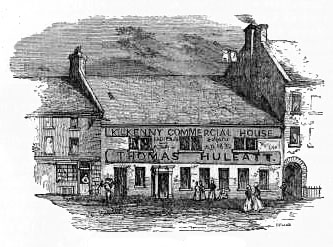Parliament of Kilkenny
The General Assembly projected by the national synod in Kilkenny, held its first meeting on October 14, 1642,—eleven spiritual and fourteen temporal peers, with 226 commoners, representing the Catholic population of Ireland. It was, in truth, a proud and glorious day for the nation. For once, at least, she could speak through channels chosen by her own free will; and for once there dawned a hope of legislative freedom of action for the long-enslaved people. The old house is still shown where that Assembly deliberated—a Parliament all but in name. The table then used, and the chair occupied by the Speaker, are still preserved, as sad mementos of freedom's blighted cause.[1] The house used was in the market-place. The peers and commoners sat together; but a private room was allotted for the lords to consult in. Dr. Patrick Darcy, an eminent lawyer, represented the Chancellor and the judges. Mr. Nicholas Plunket was chosen as Speaker; the Rev. Thomas O'Quirk, a learned Dominican friar, was appointed Chaplain to both houses.
The Assembly at once declared that they met as a provisional government, and not as a parliament. The preliminary arrangements occupied them until the 1st of November. From the 1st until the 4th, the committee was engaged in drawing up a form for the Confederate Government; on the 4th it was sanctioned by the two houses. Magna Charta, and the common and statute law of England, in all points not contrary to the Catholic religion, or inconsistent with the liberty of Ireland, were made the basis of the new Government. The administrative authority was vested in a Supreme Council, which was then chosen, and of which Lord Mountgarret was elected President.

Parliament House, Kilkenny
There were six members elected for each province. For Leinster, the Archbishop of Dublin, Lords Gormanstown and Mountgarret, Nicholas Plunket, Richard Belling, and James Cusack. For Ulster, the Archbishop of Armagh, the Bishop of Down, Philip O'Reilly, Colonel MacMahon, Heber Magennis, and Turlough O'Neill. For Munster, Viscount Roche, Sir Daniel O'Brien, Edmund FitzMaurice, Dr. Fennell, Robert Lambert, and George Comyn. For Connaught, the Archbishop of Tuam, Viscount Mayo, the Bishop of Clonfert, Sir Lucas Dillon, Geoffrey Browne, and Patrick Darcy. The Earl of Castlehaven, who had just escaped from his imprisonment in Dublin, was added as a twenty-fifth member. Generals were appointed to take the command of the forces—Owen Roe O'Neill, for Ulster; Preston, for Leinster; Barry, for Munster; and Burke, for Connaught. A seal was made, a printing-press set up, and a mint established. Money was coined and levied for the necessary expenses; and a levy of 31,700 men was prepared to be drilled by the new officers. Envoys were sent to solicit assistance from the Catholic courts of Europe; and the famous and learned Franciscan, Father Luke Wadding, applied himself to the cause with unremitting earnestness. Father John Talbot was employed in a similar manner in Spain.
